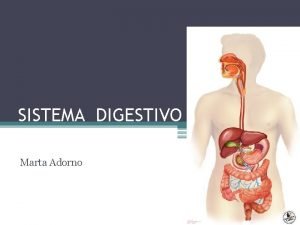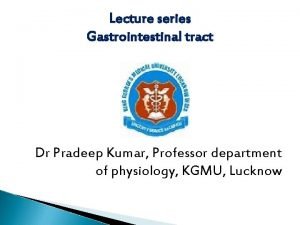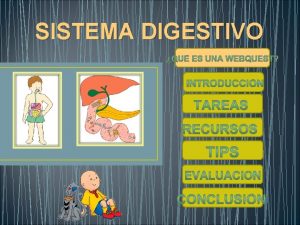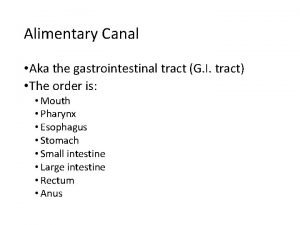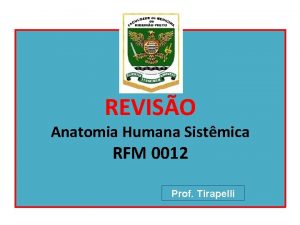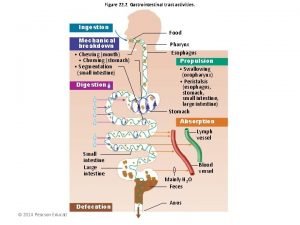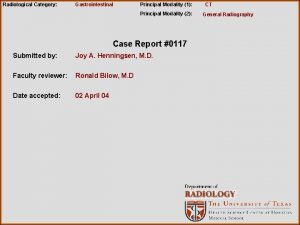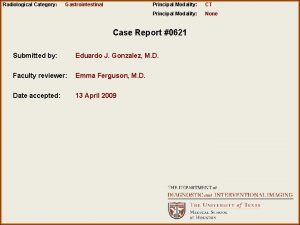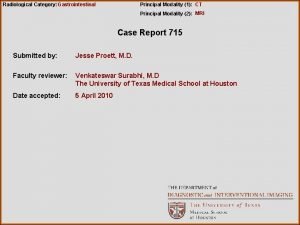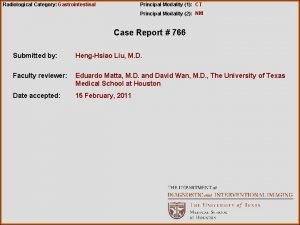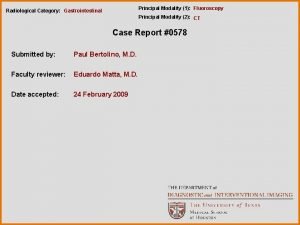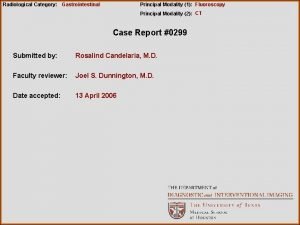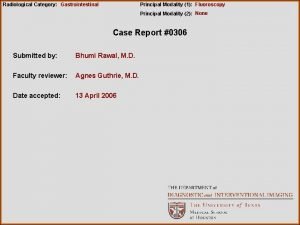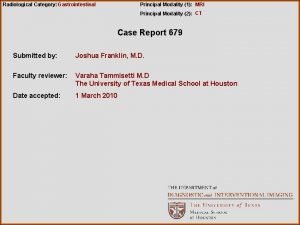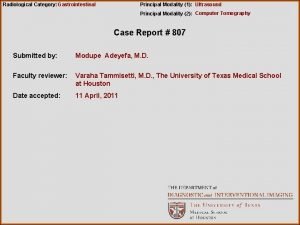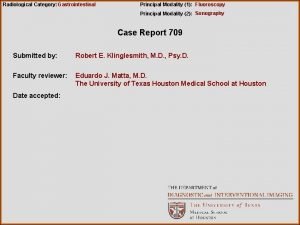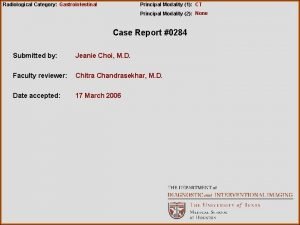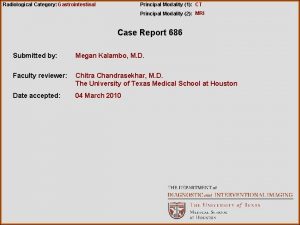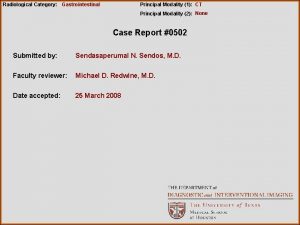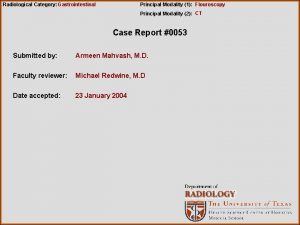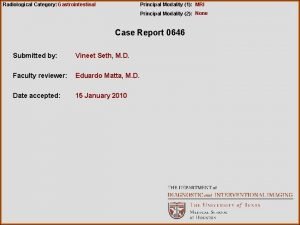Radiological Category Gastrointestinal Principal Modality 1 CT Principal

















- Slides: 17

Radiological Category: Gastrointestinal Principal Modality (1): CT Principal Modality (2): Fluoroscopy Case Report #0184 Submitted by: Anjali Roy , M. D. Faculty reviewer: Bharat Raval, M. D. Date accepted: 15 February 2005

Case History 42 year old male presents with abdominal pain, diarrhea and weight loss.

CT of the Abdomen: Pre-contrast image

CT of the Abdomen: Post-contrast image 1

CT of the Abdomen: Post-contrast image 2

CT of the Abdomen: Post-contrast image 3

Small Bowel Follow Through: Spot images RLQ LLQ

Small Bowel Follow Through: Spot images LUQ

Test Your Diagnosis Which one of the following is your choice for the appropriate diagnosis? After your selection, go to next page. • Metastatic carcinoid. • Gastrointestinal lymphoma. • Mesenteric panniculitis/ retractile mesenteritis. • Hepatocellular carcinoma with radiation enteritis. • Desmoplastic small round cell tumor.

Findings and Differentials Findings: CT : - Thickening of the terminal ileum. - Spiculated, stellate, ill-defined , inflitrating mesenteric mass. - Enhancing masses of various sizes in both hepatic lobes. - Tethered ileal loops with slightly thickened bowel walls. Small Bowel Follow through: - Spiculation and tethering of bowel loops with small bowel separation and slight dilatation of pelvic loops. - Persistently narrowed terminal ileum with thickened folds, spiculation and tethering.

Findings and Differentials: 1. Carcinoid of terminal ileum with liver metastases and mesenteric involvement. 2. Non-Hodgkin’s lymphoma of terminal ileum with mesenteric and liver involvement. 3. Desmoplastic small round cell tumor.

Discussion Carcinoid tumors ( amine precursor uptake and decarboxylation tumors ) may be found anywhere in the gastrointestinal tract, genitourinary tract or bronchi. The most common sites are the appendix followed by distal ileum. All are potentially malignant. Tumor greater than 2 cm diameter are more likely to metastasize. These tumors are hormonally active and secrete serotonin, which is converted by the liver to 5 -HIAA. Carcinoids are usually asymptomatic. In 10 per cent of cases, hormonally active hepatic metastases develop and produce the carcinoid syndrome of recurrent diarrhea, endocardial fibroelastosis involving right-sided valves, wheezing and facial flushing.

Discussion Ileal carcinoids tend to grow through the bowel wall and invade the mesentery, where they form masses that become larger than the primary tumor. These can cause intense desmoplastic constriction of mesenteric vessels together with further reaching elastic sclerosis, leading to bowel ischemia expressed as bowel wall thickening, angulation, tethering and possible partial bowel obstruction. Radiographic findings include: - Filling defect in appendix or small bowel ( primary tumor ) - Angulation, kinking and tethering of bowel loops and mesenteric vascular congestion (sec. to desmplastic reaction). -Spiculated mesenteric mass with spoke wheel pattern that may have dystrophic calcifications. -Hypervascular liver metastases with strong enhancement on CT. -Obstruction secondary to desmoplastic reaction.

Discussion Complications include ischemia with mesenteric venous compromise, hemorrhage, intussusception and malignant degeneration. Gastric and appendiceal tumors rarely metastasize. Small bowel tumors metastasize commonly. Small bowel non- Hodgkin's lymphoma most commonly occurs in the distal ileum because of predominance of lymphoid tissue in this region and has a variety of radiographic appearances. These include fold thickening or effacement, luminal narrowing, aneurysmal dilatation, diffuse nodularity and extrinsic compression by mesenteric masses. Solitary or multiple mural masses can also be seen. With continued enlargement, these masses may become exoenteric, undergoing ulceration or excavation, or endoenteric, producing an intraluminal polypoid mass with the potential for intussusception. Non-Hodgkin’s lymphoma of small bowel can be associated with celiac disease, AIDS and immunosuppression in post-transplant patients.

Discussion Demoplastic small round cell tumor is an aggressive malignancy occurring in adolescents and young adults. Radiographic findings include multiple peritoneal based soft tissue masses with hemorrhage and necrosis. Hematogenous or serosal liver metastases can be present without detectable primary tumor.

Diagnosis Carcinoid tumor of terminal ileum with mesenteric involvement and hepatic metastasis.

References Halpert Robert D. , Feczko Peter J. , Gastrointestinal Radiology: The Requisites, 2 nd edition, 1999, Mosby, St. Louis MO. Buck JL, Sobin LH, Carcinoids of the gastrointestinal tract, Radiographics 10: 10811095, 1990. Levine Marc S. , Rubesin Stephen E. , Laufer Igor, Double Contrast Gastrointestinal Radiology, 3 rd edition, 2000, W. B. Saunders, Philadelphia, PA.
 Aerohive erate
Aerohive erate Center for devices and radiological health
Center for devices and radiological health National radiological emergency preparedness conference
National radiological emergency preparedness conference Radiological dispersal device
Radiological dispersal device Tennessee division of radiological health
Tennessee division of radiological health Emt chapter 18 gastrointestinal and urologic emergencies
Emt chapter 18 gastrointestinal and urologic emergencies Distal organ
Distal organ Onde ocorre a digestão
Onde ocorre a digestão Livores violáceos
Livores violáceos Gastrointestinal structure
Gastrointestinal structure Embriologia del sistema gastrointestinal
Embriologia del sistema gastrointestinal Gastrointestinal tract
Gastrointestinal tract Chapter 15 the gastrointestinal system
Chapter 15 the gastrointestinal system Hirschsprung disease nursing management
Hirschsprung disease nursing management Encéfalo
Encéfalo Gastrik inhibitör polipeptid
Gastrik inhibitör polipeptid Gastrointestinal
Gastrointestinal Gastrointestinal tract
Gastrointestinal tract







